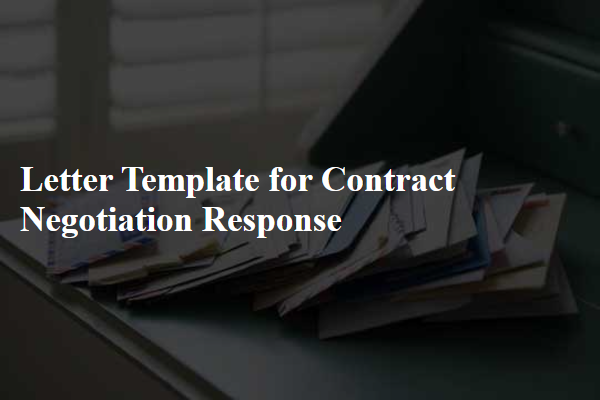Are you diving into the world of contract negotiations? Navigating these discussions can sometimes feel overwhelming, but having the right approach can make all the difference. Crafting a thoughtful response can help clarify your position and set the stage for a successful outcome. So, let's explore some essential letter templates that will make your negotiation process smoother and more effectiveâkeep reading to uncover valuable insights!

Initial Greeting and Introduction
Effective contract negotiation requires clear communication and a collaborative approach. Establishing a positive initial greeting fosters goodwill, which is essential for productive discussions. Begin with expressions of appreciation for the opportunity to negotiate, recognizing the counterpart's time and effort. An introduction should succinctly highlight the parties involved, name and role, elaborating on the context of the negotiation, such as the specific agreement or project at hand, company objectives, and mutual benefits expected from the finalized contract. This proactive engagement sets a respectful tone, encourages openness, and paves the way for successful negotiations.
Purpose of the Response
In a contract negotiation scenario, the purpose of the response is to clarify terms and conditions, ensuring mutual understanding between parties involved. Key components include addressing specific clauses, timelines, and obligations that may impact future performance. For example, responding to a proposed rate increase, it is important to cite previous agreements (such as the 2022 contract) and provide market comparison data to support arguments. Furthermore, highlighting specific deliverables, such as quarterly performance reports, assists in establishing clear expectations. A well-crafted response aims to foster collaboration, minimize misunderstandings, and seek a fair resolution beneficial for all parties, ultimately leading to a signed agreement.
Acknowledgment of Terms
Contract negotiations often include critical components like acknowledgment of terms. Clear communication of all provisions is essential. Parties involved should thoroughly review essential terms, such as payment schedules (monthly or quarterly), deliverable timelines (specific dates), and termination clauses (30 days notice). It is crucial to clarify any ambiguous language to prevent misunderstandings, especially regarding warranties and liabilities. Ensuring all parties understand the scope of work is vital to successful negotiations. Thorough documentation allows for smoother conversations in future dealings and establishes a solid foundation of mutual understanding and respect for all involved entities.
Proposed Adjustments or Counterpoints
During contract negotiations, proposed adjustments or counterpoints can significantly influence the terms of the agreement. In the context of a service contract, for instance, revisions to payment terms may include extending the payment period from 30 days to 60 days (in alignment with industry standards). Additionally, service level agreements (SLAs) could be adjusted to reflect more realistic response times for technical support, shifting from 24 hours to 48 hours for non-critical issues. Also, including a clause for regular performance reviews (quarterly evaluations) ensures continuous alignment between both parties. This level of detail fosters transparency and adaptability in the evolving business landscape, ultimately leading to a more satisfactory partnership.
Closing Remarks and Call to Action
Contract negotiations often require careful consideration of terms and conditions to ensure mutual benefit for all parties involved. During the final stages of discussions, it's essential to outline closing remarks clearly articulating key agreements. Incorporate specific points of contention addressed throughout the negotiation to reinforce progress made. Highlight critical dates, such as the contract signing deadline, to prompt timely responses. Encourage open lines of communication for any last-minute clarifications or adjustments needed before finalizing the agreement. Emphasize the importance of partnership moving forward to create a collaborative atmosphere that enhances the commitment to shared goals. Provide clear contact information to facilitate swift dialogue and promote actionable next steps in the negotiation process.













Comments